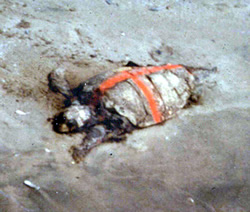Sea Turtle Stranding and Salvage Network
 The
Sea Turtle Stranding and Salvage Network (STSSN) is set up to provide
statewide information on sea turtle strandings and to assess the
effectiveness of the Turtle Excluder Device (TED) regulations. The
STSSN is part of a multi-regional network coordinated by the National
Marine Fisheries Service (NMFS). Aerial surveys augment the volunteer
network. Network members document strandings on beaches. Members
of the network consist of SCDNR staff, U.S. Fish and Wildlife Service
employees, and private citizens. Remote islands are surveyed by fixed
wing aircraft. Volunteers are trained to correctly identify species
and to properly collect data. Reports of unusual specimens are verified
by the principal investigator whenever possible. All carcasses are
measured in a standardized way as recommended by NMFS and marked
with orange paint to avoid duplication of counts. Reports of strandings
are submitted to the NMFS, Southeast Fisheries Science Center in
Miami each week. Monthly reports are distributed to network members,
federal agencies, conservation groups, and other interested parties.
These data are compared with stranding numbers from previous years
to evaluate the effectiveness of TED implementation. Click
here for more information on sea turtle strandings.
The
Sea Turtle Stranding and Salvage Network (STSSN) is set up to provide
statewide information on sea turtle strandings and to assess the
effectiveness of the Turtle Excluder Device (TED) regulations. The
STSSN is part of a multi-regional network coordinated by the National
Marine Fisheries Service (NMFS). Aerial surveys augment the volunteer
network. Network members document strandings on beaches. Members
of the network consist of SCDNR staff, U.S. Fish and Wildlife Service
employees, and private citizens. Remote islands are surveyed by fixed
wing aircraft. Volunteers are trained to correctly identify species
and to properly collect data. Reports of unusual specimens are verified
by the principal investigator whenever possible. All carcasses are
measured in a standardized way as recommended by NMFS and marked
with orange paint to avoid duplication of counts. Reports of strandings
are submitted to the NMFS, Southeast Fisheries Science Center in
Miami each week. Monthly reports are distributed to network members,
federal agencies, conservation groups, and other interested parties.
These data are compared with stranding numbers from previous years
to evaluate the effectiveness of TED implementation. Click
here for more information on sea turtle strandings.
Online stranding data can be viewed here: http://www.seaturtle.org/strand/. Live sea turtles are taken to the South Carolina Aquarium's Sea Turtle Care Center.
Stranding Network Species Identification Guide - This series of photographs with captions aids in identifying sea turtle carcasses. Methodology for measuring carcasses is also covered.
Find out who to call if you find a dead, sick, or injured sea turtle.
If you find a dead, sick, or injured sea turtle, please call SCDNR's 24-hour hotline 1-800-922-5431.
Please be prepared to answer the following questions:
- What is the exact location of the animal?
- Is the turtle alive or dead?
- What is the approximate size of the turtle?
- Is the turtle marked with spray paint? (This may indicate that the turtle has been previously documented.)
- What is the location of the closest access point to the turtle?
If the turtle is alive, please be prepared to stay with it until help arrives.



